The Effects of Five Forms of Capital on Thought Processes Underlying Water Consumption Behavior in Suburban Vientiane
Abstract
:1. Introduction
2. Methods
2.1. Sustainable Livelihood Framework
2.2. Conducting the Survey
- The first part included a basic household profile, such as the address, demographics, academic backgrounds, employment, and economic status. This part indicated a household’s natural, human, and financial capital. The address was used to determine the availability of groundwater.
- The second part consisted of information about the household water sources and how water from each source was used for various purposes. This part aimed to explain household water consumption behaviors.
- The third part considered the household situation with regard to water supply, such as the stability of water pressure, the monthly fee for the connection, installation cost, and reasons for not connecting to the water supply, as appropriate.
- The fourth part consisted of information about water availability from each source. In the survey area, various water sources were used, and they had different characteristics, such as quality, price, and stability.
- The final part asked about the household’s access to information about the water supply infrastructure. This part revealed the social capital of the household.
2.3. Sampling Method
3. Results and Discussion
3.1. Water Consumption Behavior in the Survey Area
3.2. Natural and Physical Capital and Connection to the Water Supply
3.3. Financial Capital and Connection to the Water Supply
3.4. Human Capital and Connection to the Water Supply
3.5. Social Capital and Connection to the Water Supply
4. Conclusions
Acknowledgments
Author Contributions
Conflicts of Interest
Abbreviations
| Lao PDR | Lao People’s Democratic Republic |
| MDGs | Millennium Development Goals |
| UN | United Nations |
| SDGs | Sustainable Development Goals |
| JICA | Japanese International Cooperation Agency |
| WS | Water Supply |
| WHO | World Health Organization |
| UNICEF | United Nation’s Children’s Fund |
References
- United Nations World Water Assessment Programme. The United Nations World Water Development Report 2015: Water for a Sustainable World; UNESCO: Paris, France, 2015; p. 2. [Google Scholar]
- White, G.F.; Bradley, D.J.; White, A.U. Drawers of Water: Domestic water use in east Africa. Bull. World Health Organ. 2002, 80, 63–73. [Google Scholar] [PubMed]
- Esrey, S.A.; Potash, J.B.; Roberts, L.; Shiff, C. Effects of improved water supply and sanitation on ascariasis, diarrhea, dracunculiasis, hookworm infection, schistosomiasis, and trachoma. Bull. World Health Organ. 1991, 69, 609–621. [Google Scholar] [PubMed]
- Gleick, P.H. Basic water requirements for human activities: Meeting basic needs. Water Int. 1996, 21, 83–92. [Google Scholar] [CrossRef]
- United Nations. The Millennium Development Goals Report 2014; United Nations: New York, NY, USA, 2014; pp. 43–45. [Google Scholar]
- WHO; UNICEF. Meeting the MDG Drinking-Water and Sanitation Target: The Urban and Rural Challenge of the Decade; UNICEF: New York, NY, USA, 2006; p. 8. [Google Scholar]
- United Nations. Report of the Open Working Group of the General Assembly on Sustainable Development Goals; United Nations: New York, NY, USA, 2014; p. 14. Available online: http://unidocs.org/A/68/970 (accessed on 19 February 2016).
- Otaki, Y.; Otaki, M.; Aramaki, T.; Sakura, O. Residential water demand analysis by household activities. In Proceedings of the 2nd International Conference on Efficient Use and Management of Urban Water Supply-Efficient, Tenerife, Spain, 2–4 April 2003; Available online: http://paginas.fe.up.pt/~mjneves/publicacoes_files/data/es/ponencias/por_autor/pdf/10053.pdf (accessed on 4 June 2016).
- United Nations Department of Economic and Social Affairs. World Urbanization Prospects: The 2014 Revision; United Nations: New York, NY, USA, 2014; p. 11. [Google Scholar]
- Cohen, B. Urban Growth in Developing Countries: A Review of Current Trends and a Caution Regarding Existing Forecasts. World Dev. 2004, 32, 23–51. [Google Scholar] [CrossRef]
- Montgomery, M.R.; Stren, R.; Cohen, B.; Reed, H.E. Cities Transformed: Demographic Change and Its Implications in the Developing World; National Academies Press: Washington, DC, USA, 2003; pp. 4–16. [Google Scholar]
- Madanat, S.; Humplick, F. A model of household choice of water supply systems in developing countries. Water Resour. Res. 1993, 29, 1353–1358. [Google Scholar] [CrossRef]
- Smith, L.; Hanson, S. Access to water for the urban poor in Cape Town: Where equity meets cost recovery. Urban Stud. 2003, 40, 1517–1548. [Google Scholar] [CrossRef]
- Hadipuro, W. Indonesia’s water supply regulatory framework: Between commercialization and public service? Water Altern. 2010, 3, 475–491. [Google Scholar]
- Nickson, R.; McArthur, J.; Burgess, W.; Ahmed, K.M.; Ravenscroft, P.; Rahmann, M. Arsenic poisoning of Bangladesh groundwater. Nature 1998, 395, 338–338. [Google Scholar] [CrossRef] [PubMed]
- Chanpiwat, P.; Sthiannopkao, S.; Cho, K.H.; Kim, K.W.; San, V.; Suvanthong, B.; Vongthavady, C. Contamination by arsenic and other trace elements of tube-well water along the Mekong River in Lao PDR. Environ. Pollut. 2011, 159, 567–576. [Google Scholar] [CrossRef] [PubMed]
- United Nations. Committee for Development Policy Report on the Seventeenth Session; United Nations Economic and Social Council: New York, NY, USA, 2015; pp. 14–17. Available online: http://www.un.org/en/development/desa/policy/cdp/cdp_ecosoc/E_2015_33_en.pdf (accessed on 4 June 2016).
- WHO; UNICEF. Progress on Drinking Water and Sanitation 2014; United Nations: New York, NY, USA, 2014; p. 61. [Google Scholar]
- Thammavongsa, S. Vientiane Water Supply System and Development Plans for Improvement. People-Centred Approaches to Water and Environmental Sanitation. In Proceedings of the 30th WEDC International Conference, Vientiane, Lao PDR, 25–29 October 2004; Water, Engineering and Development Centre: Loughborough, UK, 2004; pp. 637–640. Available online: http://wedc.lboro.ac.uk/resources/conference/30/Thammavongsa.pdf (accessed on 4 June 2016). [Google Scholar]
- Asian Development Bank. Water in Asian Cities: Utilities Performance and Civil Society Views; Asian Development Bank: Manila, Philippines, 2004; p. 66. [Google Scholar]
- Japanese International Cooperation Agency. The Study on Vientiane Water Supply Development Project in Lao People’s Democratic Republic: Final Report Vol. 2.. Main Report: Master Plan; Japan International Cooperation Agency: Nihon Suido Consultants Co.: Tokyo, Japan, 2004; p. 1. Available online: http://open_jicareport.jica.go.jp/618/618/618_112_11751260.html (accessed on 21 February 2016).
- Ministry of Health and Lao Statistics Bureau. Lao Social Indicator Survey 2011–12; Ministry of Health and Lao Statistics Bureau: Vientiane, Lao PDR, 2012; pp. 21–27. Available online: https://dhsprogram.com/pubs/pdf/FR268/FR268.pdf (accessed on 21 February 2016).
- Schmoll, O.; Howard, G.; Chilton, J.; Chorus, I. (Eds.) Protecting Groundwater for Health: Managing the Quality of Drinking-Water Sources; IWA Publishing: London, UK, 2006; pp. 7–8.
- Fengthong, T.; Dethoudom, S.; Keosavanh, O. Drinking Water Quality in the Lao People’s Democratic Republic. In Seminar on the Environmental and Public Health Risks due to Contamination of Soils, Crops, Surface and Groundwater from Urban, Industrial and Natural Sources in Southeast Asia, Hanoi, Vietnam, 10–12 December 2002; Available online: http://publications.iwmi.org/pdf/H033492.pdf (accessed on 4 June 2016).
- Ellis, F. Rural Livelihood Diversity in Developing Countries: Evidence and Policy Implications; Overseas Development Institute: London, UK, 1991; pp. 4–51. [Google Scholar]
- Solesbury, W. Sustainable Livelihoods: A Case Study of the Evolution of DFID Policy; Overseas Development Institute: London, UK, 2003; pp. 3–13. [Google Scholar]
- Nussbaum, M.; Sen, A. The Quality of Life; Clarenton Press: Oxford, UK, 1993; pp. 30–53. [Google Scholar]
- Sen, A. Human capital and human capability. World Dev. 1997, 25, 1959–1961. [Google Scholar] [CrossRef]
- Chambers, R.; Conway, G. Sustainable Rural Livelihoods: Practical Concepts for the 21st Century; Institute of Development Studies: Brighton, UK, 1992; p. 4. [Google Scholar]
- Sullivan, C.A.; Meigh, J.R.; Giacomello, A.M.; Fediw, T.; Lawrence, P.; Samad, M.; Molte, S.; Hutton, C.; Allan, J.A.; Schulze, R.E.; et al. The water poverty index: Development and application at the community scale. In Natural Resources Forum; Blackwell Publishing Ltd.: Oxford, UK, 2008; pp. 189–199. [Google Scholar]
- Merrey, D.J.; Drechsel, P.; de Vries, F.P.; Sally, H. Integrating “livelihoods” into integrated water resources management: Taking the integration paradigm to its logical next step for developing countries. Reg. Environ. Chang. 2005, 5, 197–204. [Google Scholar] [CrossRef]
- Cohen, A.; Sullivan, C.A. Water and poverty in rural China: Developing an instrument to assess the multiple dimensions of water and poverty. Ecol. Econ. 2010, 69, 999–1009. [Google Scholar] [CrossRef]
- Gleick, P.H. The Myth and Reality of Bottled Water. In The Biennial Report on Freshwater Resources: 2004–2005; Island Press: Washington, DC, USA, 2015; pp. 17–43. Available online: http://pacinst.org/wp-content/uploads/2013/04/myth_and_reality.pdf (accessed on 24 April 2016).
- Hoque, B.A.; Juncker, T.; Sack, R.B.; Ali, M.; Aziz, K.M. Sustainability of a water, sanitation and hygiene education project in rural Bangladesh: A 5-year follow-up. Bull. World Health Organ. 1996, 74, 431–437. [Google Scholar] [PubMed]
- Glanville, J.L.; Bienenstock, E.J. A Typology for Understanding the Connections Among Different Forms of Social Capital. Am. Behav. Sci. 2009, 52, 1507–1530. [Google Scholar] [CrossRef]
- Onwuegbuzie, A.J.; Collins, K.M. A typology of mixed methods sampling designs in social science research. Qual. Rep. 2007, 12, 281–316. [Google Scholar]
- Mann, H.B.; Whitney, D.R. On a test of whether one of two random variables is stochastically larger than the other. Ann. Math. Stat. 1947, 18, 50–60. [Google Scholar] [CrossRef]
- Nachar, N. The Mann-Whitney U: A Test for Assessing Whether Two Independent Samples Come from the Same Distribution. Tutor. Quant. Methods Psychol. 2008, 4, 13–20. [Google Scholar]
- Mu, X.; Whittington, D.; Briscoe, J. Modeling village water demand behavior: a discrete choice approach. Water Resour. Res. 1990, 26, 521–529. [Google Scholar] [CrossRef]
- Behrman, J.R.; Deolalikar, A.B. Will developing country nutrition improve with income? A case study for rural South India. J. Polit. Econ. 1978. [Google Scholar] [CrossRef]
- Subramanian, S.; Deaton, A. The demand for food and calories. J. Polit. Econ. 1996. [Google Scholar] [CrossRef]
- WWAP (United Nations World Water Assessment Programme). Poverty and social equity. In The United Nations World Water Development Report 2015: Water for a Sustainable World; United Nations Educational, Scientific and Cultural Organization: Paris, France, 2015; pp. 19–22. [Google Scholar]
- Nyong, A.O.; Kanaroglou, P.S. A survey of household domestic water-use patterns in rural semi-arid Nigeria. J. Arid Environ. 2001, 49, 387–400. [Google Scholar] [CrossRef]
- Pinfold, J.V.; Horan, N.J.; Wirojanagud, W.; Mara, D. The bacteriological quality of rainjar water in rural northeast Thailand. Water Res. 1993, 27, 297–302. [Google Scholar] [CrossRef]
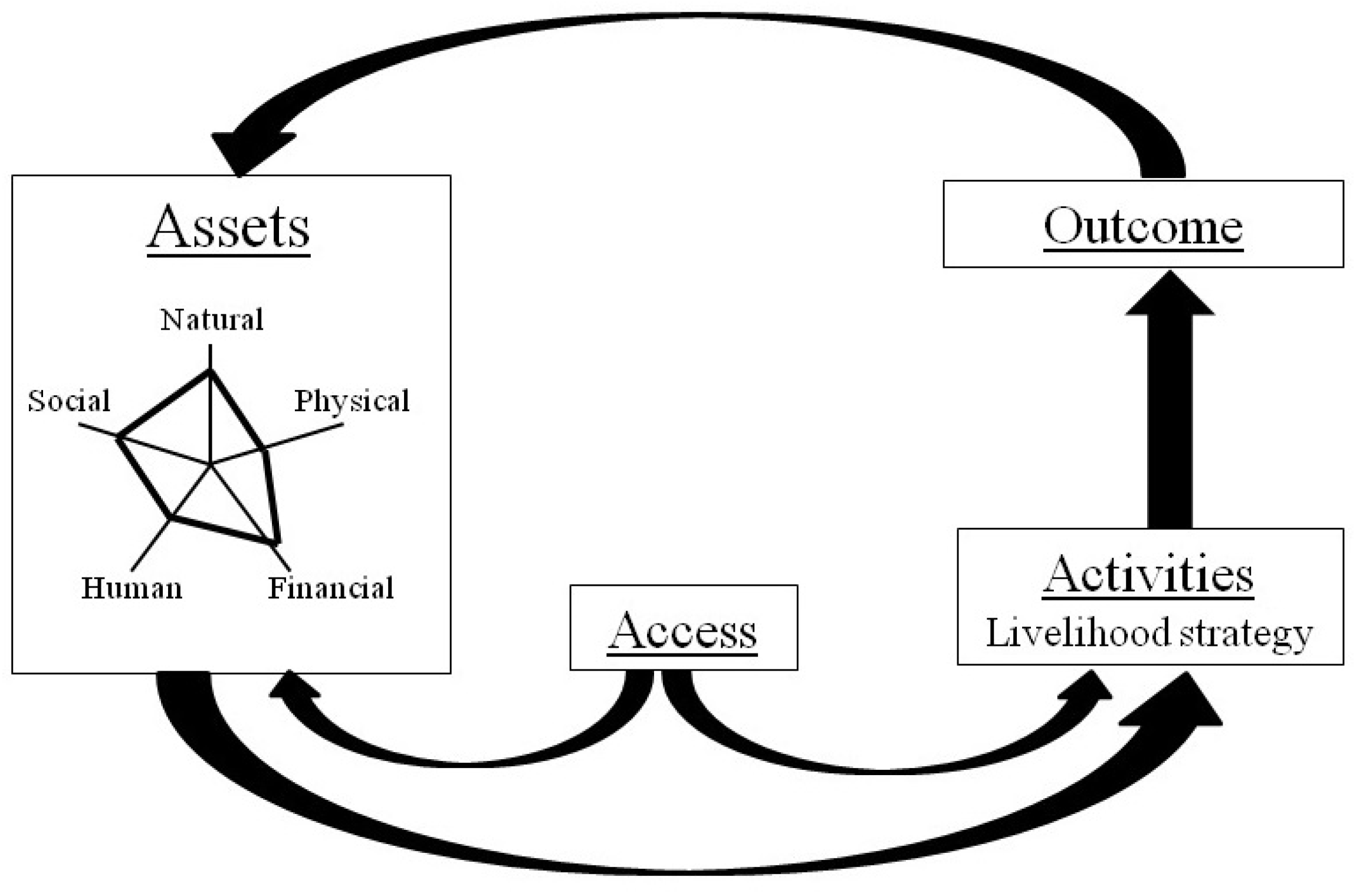

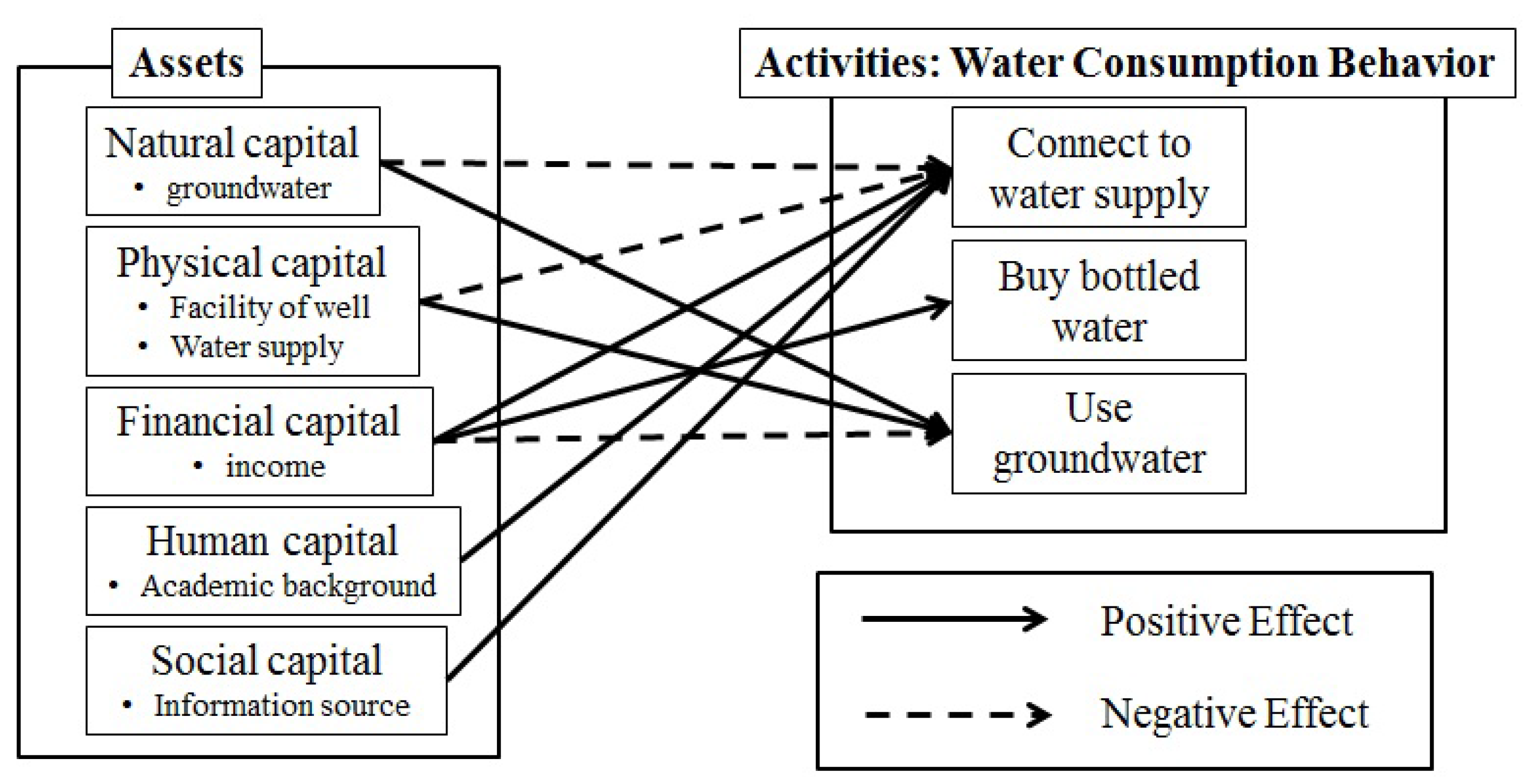
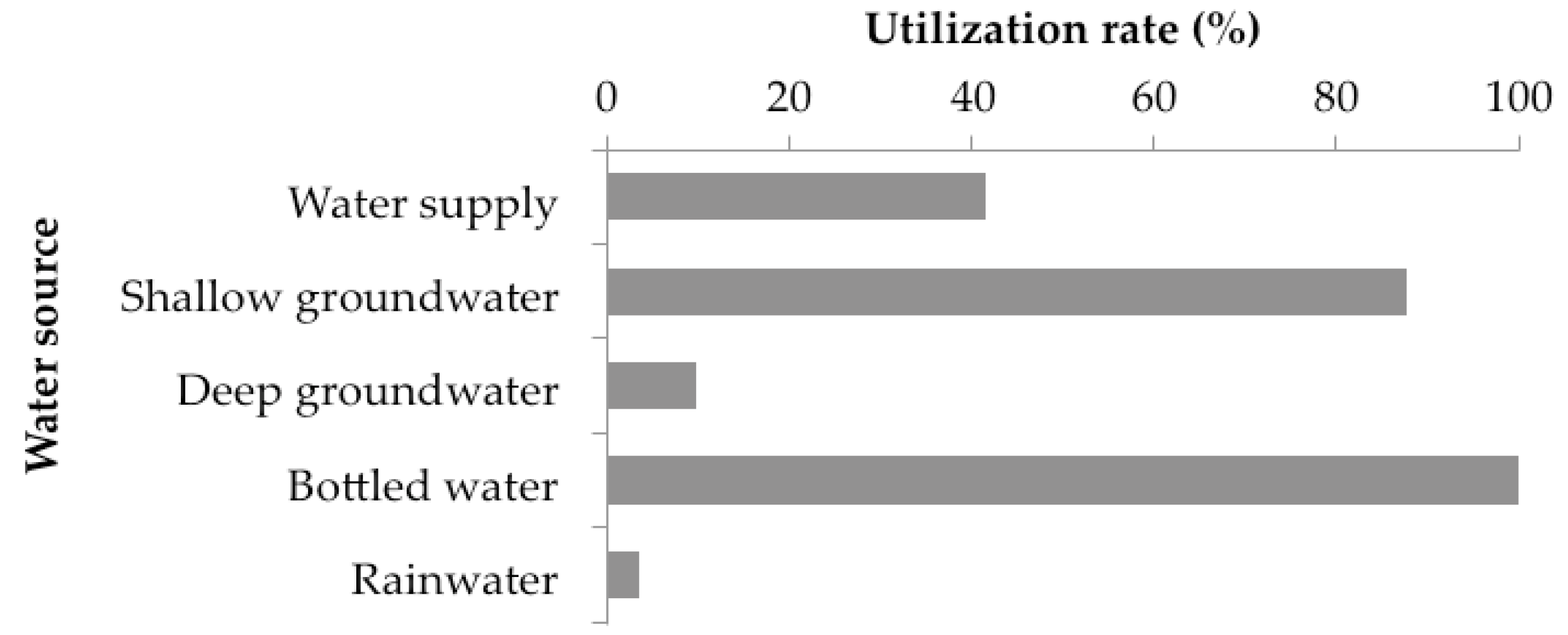
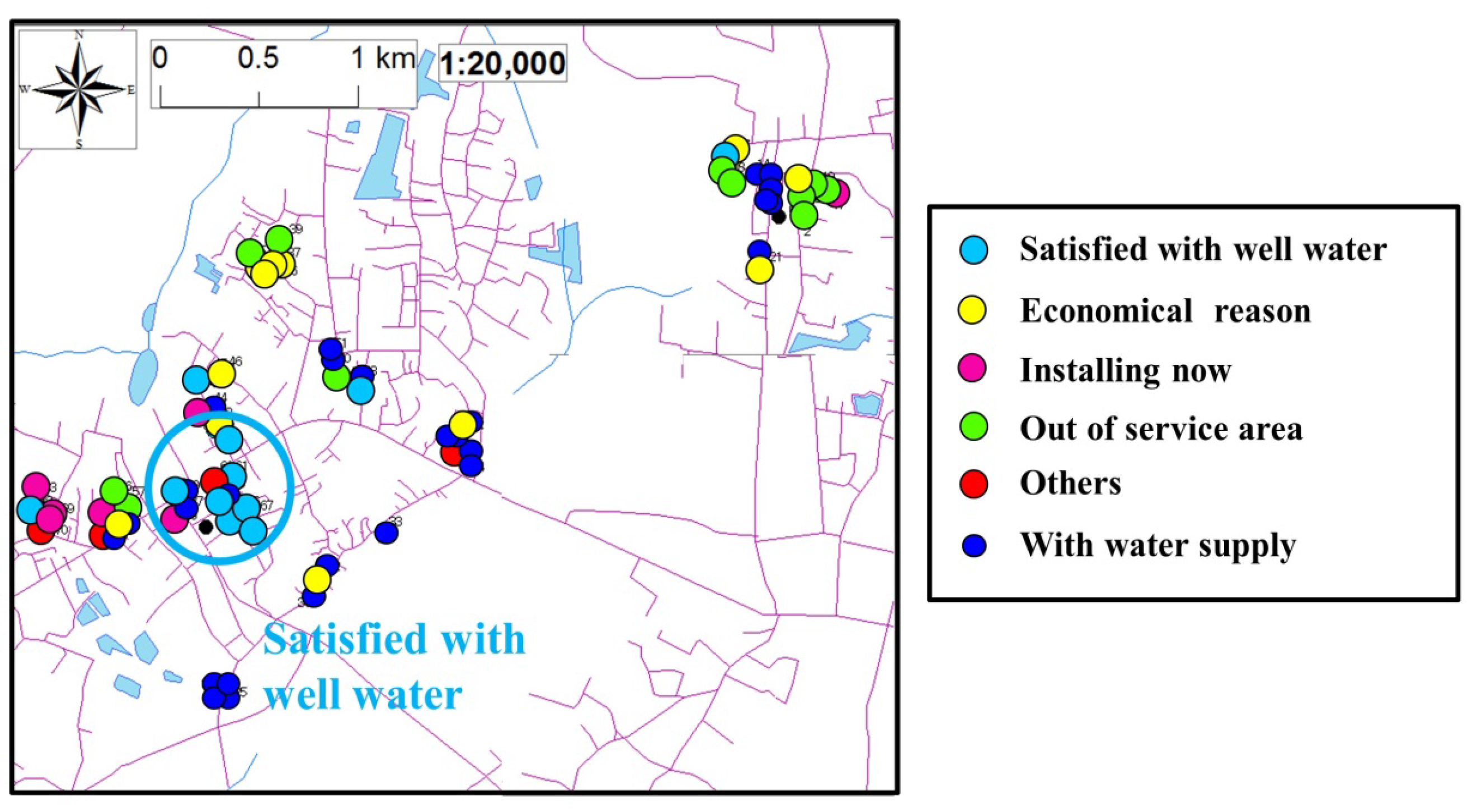

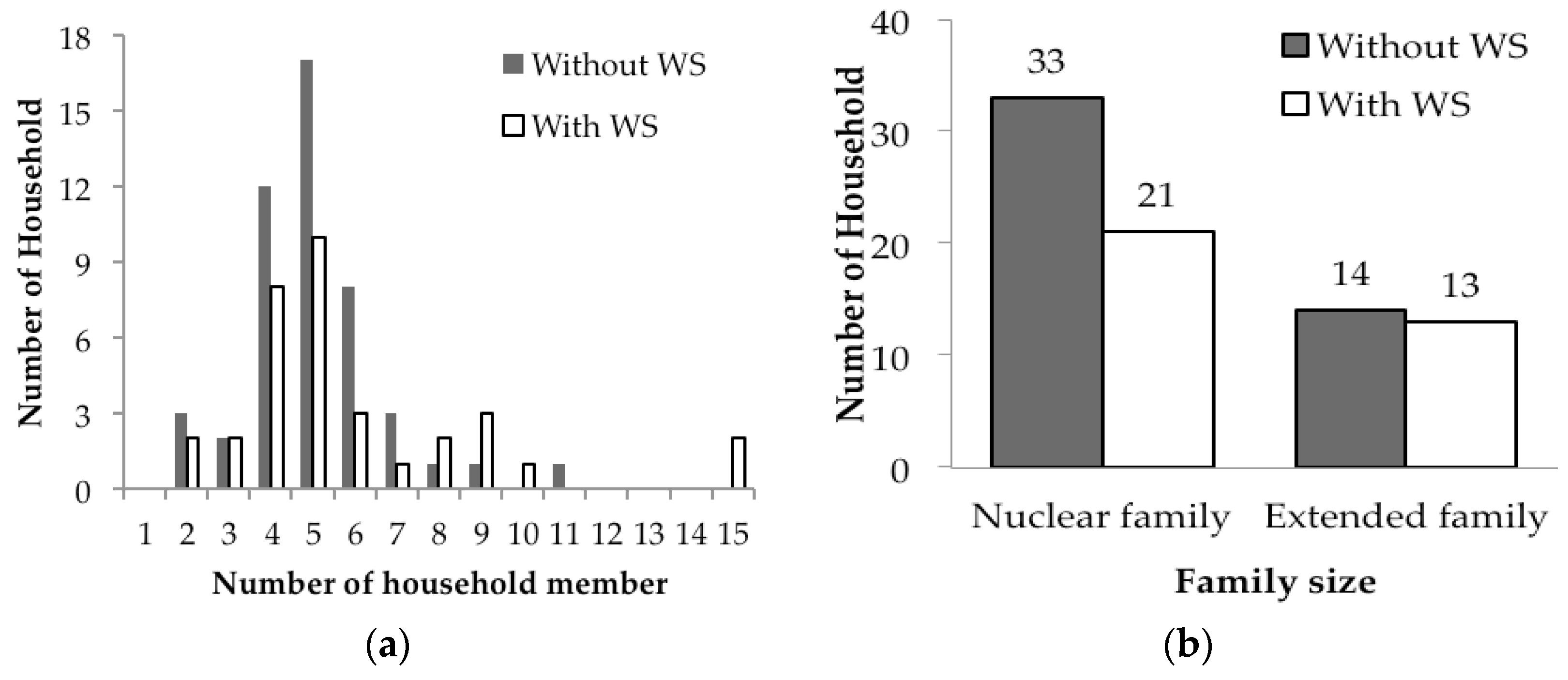
| Village | Nataum | Nonphanhang |
|---|---|---|
| Population | 2323 | 7485 |
| Households | 485 | 1498 |
| Sampled households | 21 | 61 |
| Source | Purpose | Characteristics |
|---|---|---|
| Water supply | Cooking, shower, washing | Unstable in some location, installation cost |
| Deep and Shallow groundwater | Cooking, shower, washing, gradening | Unable in the end of dry season |
| Bottled water | Drinking, cooking | A bit expensive, clean |
| Rainwater | Gardening, drinking | Available mainly in rainy season |
© 2016 by the authors; licensee MDPI, Basel, Switzerland. This article is an open access article distributed under the terms and conditions of the Creative Commons Attribution (CC-BY) license (http://creativecommons.org/licenses/by/4.0/).
Share and Cite
Makino, T.; Noda, K.; Keokhamphui, K.; Hamada, H.; Oki, K.; Oki, T. The Effects of Five Forms of Capital on Thought Processes Underlying Water Consumption Behavior in Suburban Vientiane. Sustainability 2016, 8, 538. https://doi.org/10.3390/su8060538
Makino T, Noda K, Keokhamphui K, Hamada H, Oki K, Oki T. The Effects of Five Forms of Capital on Thought Processes Underlying Water Consumption Behavior in Suburban Vientiane. Sustainability. 2016; 8(6):538. https://doi.org/10.3390/su8060538
Chicago/Turabian StyleMakino, Tatsuya, Keigo Noda, Keoduangchai Keokhamphui, Hiromasa Hamada, Kazuo Oki, and Taikan Oki. 2016. "The Effects of Five Forms of Capital on Thought Processes Underlying Water Consumption Behavior in Suburban Vientiane" Sustainability 8, no. 6: 538. https://doi.org/10.3390/su8060538
APA StyleMakino, T., Noda, K., Keokhamphui, K., Hamada, H., Oki, K., & Oki, T. (2016). The Effects of Five Forms of Capital on Thought Processes Underlying Water Consumption Behavior in Suburban Vientiane. Sustainability, 8(6), 538. https://doi.org/10.3390/su8060538






